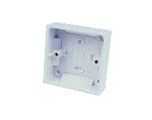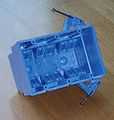Pattress
A pattress or pattress box is the container for the space behind electrical fittings such as power outlet sockets and light switches. Pattresses may be designed for either surface mounting (with cabling running along the wall surface) or for embedding in the wall or skirting board. Some electricians use the term "pattress box" to describe a surface-mounted box, although simply the term "pattress" suffices. The term "flush box" is used for a mounting box that goes inside the wall, although some use the term "wall box". Boxes for installation within timber/plasterboard walls are usually called "cavity boxes" or "plasterboard boxes". British English speakers also tend to say "pattress box" instead of just "pattress". Pattress is alternatively spelt "patress" and Wiktionary lists both spellings. The word "pattress", despite being attested from the late 19th century, is still rarely found in most dictionaries. It is etymologically derived from pateras (Latin for bowls, saucers).[1][2][3]
The term "pattress" is rarely seen in the United States or Canada, where the equivalent term is device box or switch box.
A pattress may be made of metal or plastic. In the United Kingdom, surface-mounted boxes in particular are often made from urea-formaldehyde resin, or alternatively PVC, and usually white. Wall boxes are commonly made of thin galvanised metal. A pattress box is made to standard dimensions and may contain embedded bushings (in standard positions) for the attachment of wiring devices (switches and sockets). Pattress boxes themselves do not include the corresponding faceplates.
Although cables may be joined inside pattress boxes, due simply to their presence at convenient points in the wiring, their main purpose is to accommodate switches and sockets. They allow switches and sockets to be recessed into the wall for a better appearance. Enclosures primarily for joining wires are called junction boxes.
Alternative systems
In some countries, for instance in Germany, wall boxes for electrical fittings generally are not actual rectangular boxes at all but standard-sized round recessed containers. This has the advantage that the corresponding round holes can be simply drilled out with a hole saw rather than needing the cutting out of a rectangular shape to accommodate the wall box. Even with those round-hole systems, the faceplates that cover them are mostly rectangular however. Round-hole systems do not appear to be common in the English-speaking world.
Image gallery
-

A single (1 gang) white plastic surface pattress box (UK pattern)
-

A double (2 gang) metal wall box for sub-surface use (UK pattern)
-

A US-style pattress/wall box with room for three light switches. This box can also be nailed sideways to a wooden beam.
-
A US-style pattress/wall box (in blue) behind two light switches. Not shown: the corresponding faceplate.
See also
| Look up pattress in Wiktionary, the free dictionary. |
- Wall anchor plates are also known as pattress plates.
- Electrical wiring in the United Kingdom
References
- ↑ http://oxforddictionaries.com/definition/pattress
- ↑ http://www.latin-dictionary.org/english-latin-online-dictionary/patera
- ↑ For more information on the terminology, see .
External links
- DIY Wiki Pattress page – more information on (British) pattresses and terminology
